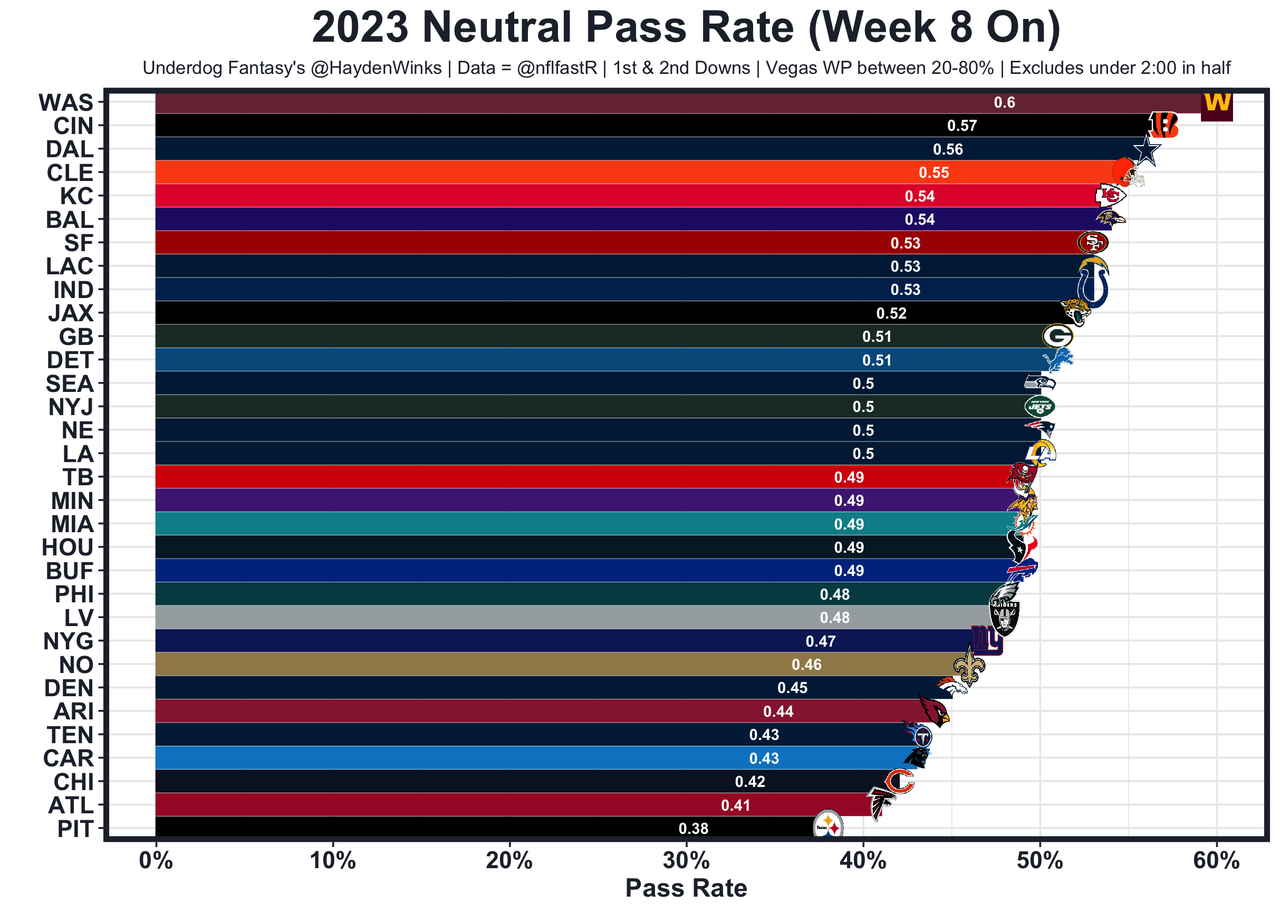2024 Fantasy Football Regression Candidates
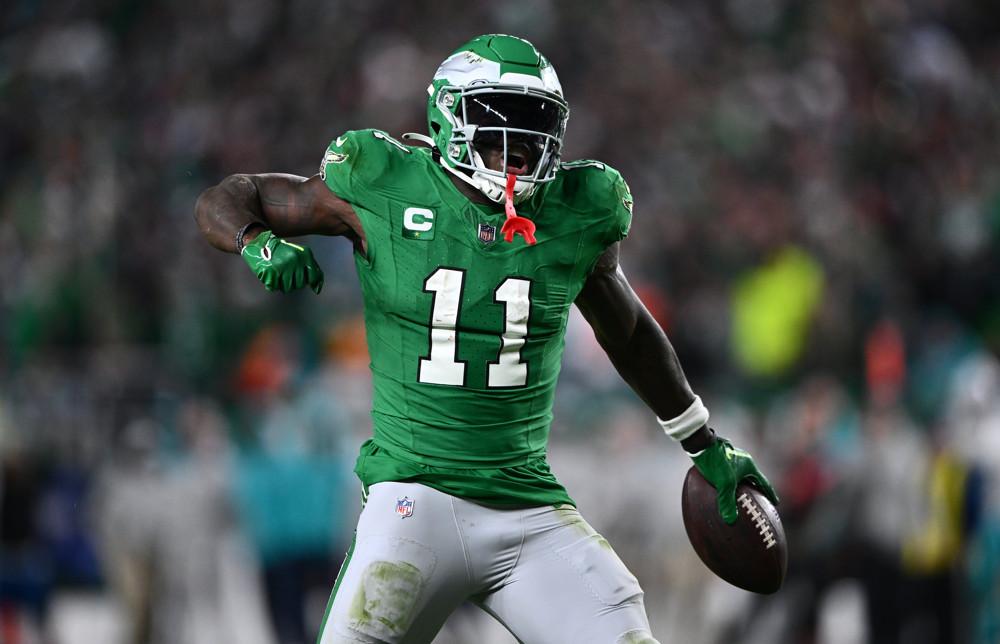
Most of the time, we can look at last year's fantasy points per game and call it a day. But there are a few dozen players who are staring down the naughtiest word in fantasy football: regression. This column will try to pin-point the true regression candidates based on some key metrics like TDs over expected, deep target catch rate, efficiency versus career averages, and "fantasy points over expected". The last metric is one derived from carries and targets adjusted for things like distance to the end zone, distance to the sideline, and yards to go. It essentially tells us how many points the average player in an average offense should score. Of course, not every player is average or in an average offense. That's on us to parse out.
2023 Fantasy Points Over Expected
The minimum qualifiers were 8 games and 3.0 expected half PPR points based on their in-game usage. The "Diff" is the percentage difference between each player's usage and their actual production, so a number above 1.00 is above average. The "Rank" is the positional ranking for each metric.
De'Von Achane: There have been 533 qualifying RBs since 2018 in my fantasy points over expected model, and Achane's 2023 season was the very best. He scored 5.4 more half PPR points than his usage would indicate, thanks to a ridiculous 5.2 TDs over expected. Achane did so with speed and contact balance, perfectly aligning with coach Mike McDaniels' outside zone and pitch-heavy scheme. His 7.4 yards per carry were the best of any RB since 2000 (min. 100 carries), but that's an unsustainable clip of course. The other 19 RBs to sit above 5.5 YPC watched their average drop by 1.1 yards the following regular season. Only once did a RB in that sample increase their YPC (Jamaal Charles).... All this said, Achane will be a model dunker for a long time in this offense. If he went from 5.4 to 3.0 fantasy points over expected this year while keeping his same usage, Achane still would've been the per-game RB14 last year. There's a chance he sees more volume this year, too, so he looks like a boom-bust low-end RB1, even after factoring in regression.
Raheem Mostert: One primary reason to believe in Achane was by just looking at what his teammate did as the lead back. Mostert scored an NFL-high 8.2 more TDs than his usage would indicate. He bullied in the red zone and ripped off explosives between the 20s. Mostert was given a $4.4M raise for his services. The 32-year-old will face competition from Achane, who is unlikely to miss as much time as he did last year, and 4th-round speedster Jaylen Wright. Mostert's is equal parts regression and playing time. In his 5 games with Achane back from injury late last year, Mostert only averaged 13.3 half PPR points. That was at 17.3 in the games prior. Those 13.3 points per game would've been good for an RB19 finish last year. He's drafted as the RB25 on Underdog Fantasy right now.
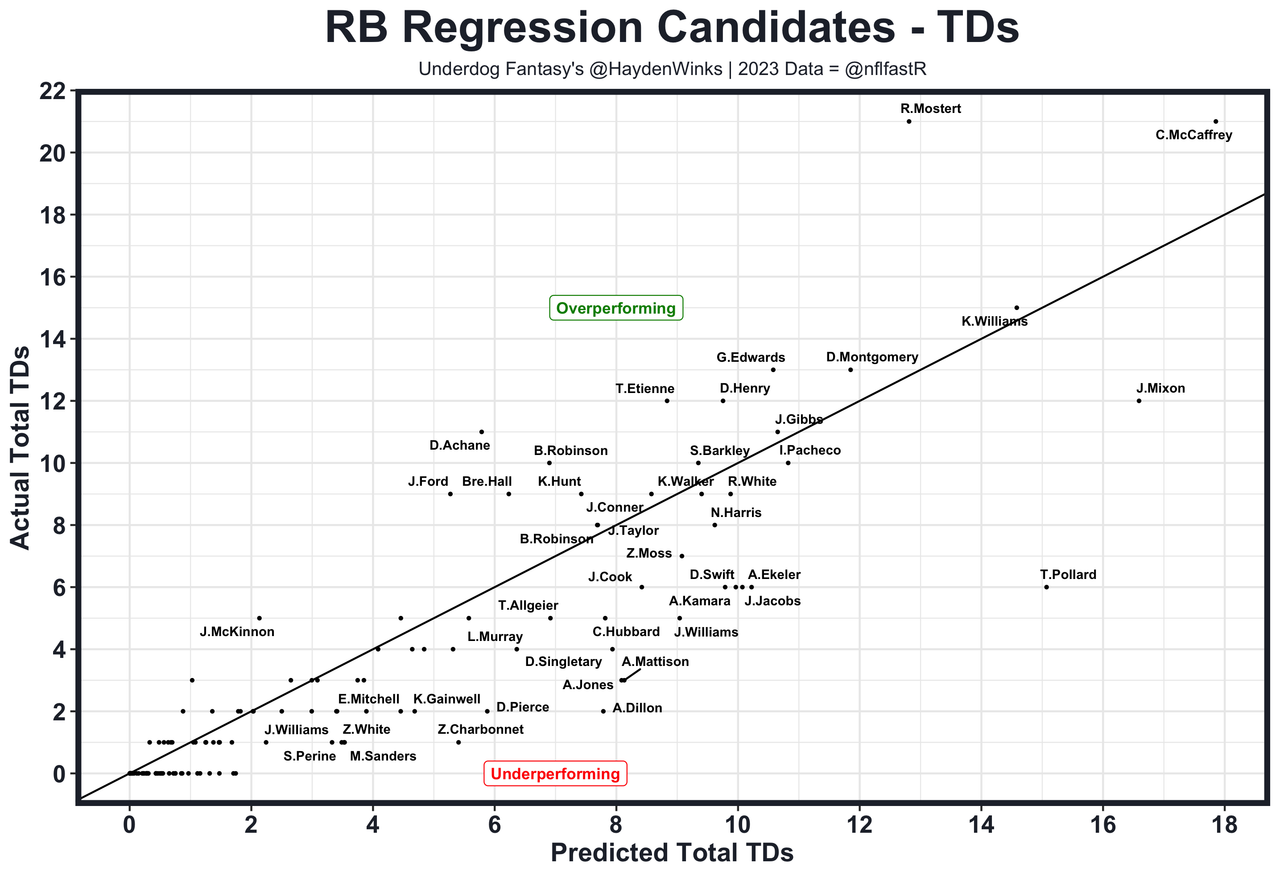
Josh Jacobs: 2023 was a disaster season after holding out through training camp. He scored 4.1 fewer TDs than expected, leading to -20% fantasy points over expected. That was by far his worst of his career. Jacobs was +15% over expected the year prior, so he's been very boom-bust as an individual player. The Packers' scoring environment is better than the Raiders', especially after Jordan Love's late-year breakout. From Week 10 on, Aaron Jones was the RB4 in fantasy usage per game (17.1 expected half PPR) while the Packers were 2nd in EPA per play. If Jacobs gets that level of work in that good of an offense, he doesn't even need to be more efficient than he was last year to be a fantasy RB1. There's a chance his individual numbers (like broken tackles and yards after contact) also improve now that he's had a normal offseason and plays for a successful organization.
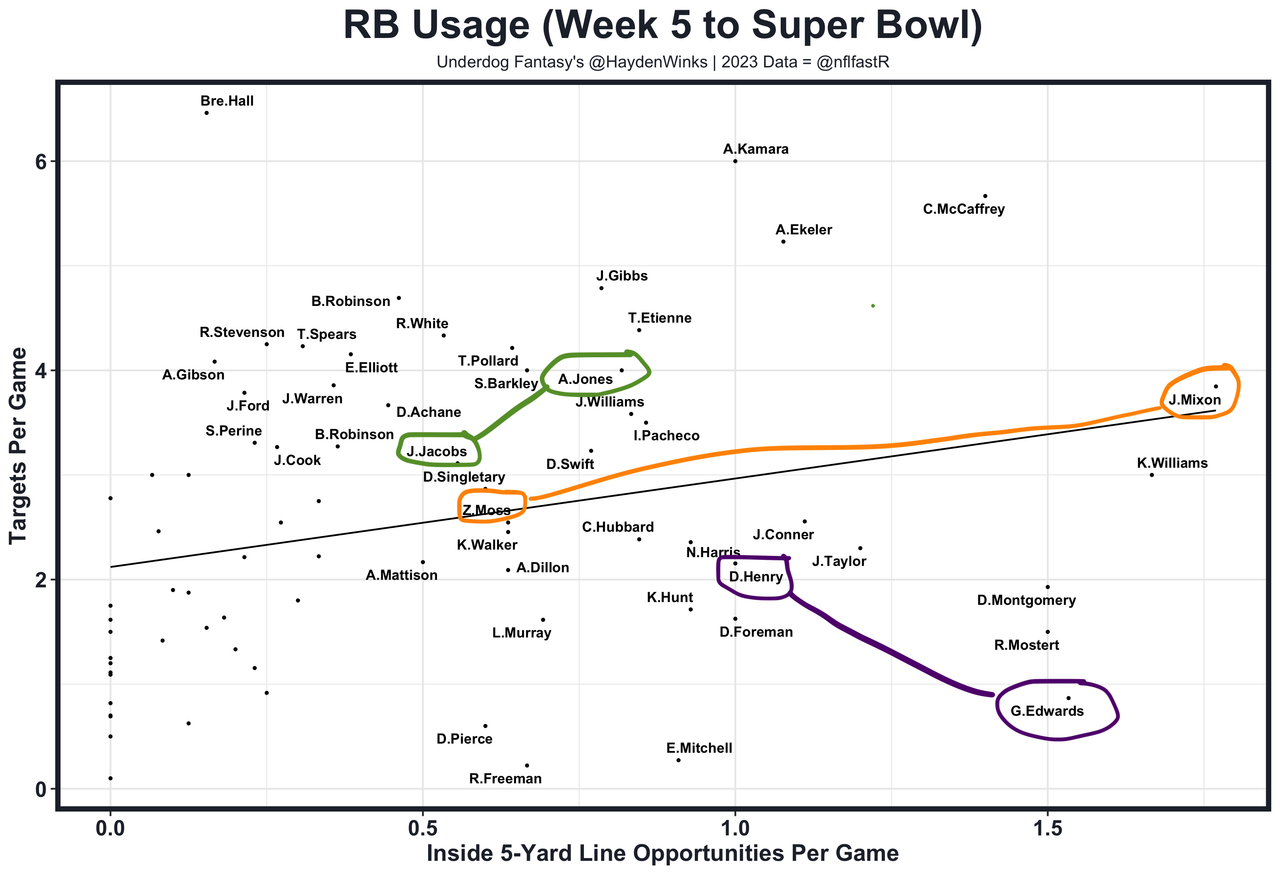
Travis Etienne: He only scored on 2-of-10 carries inside the 5-yard line in 2022, leading to an offseason full of "can he be a short-yardage back?" conversations. The Jaguars whiffed on Tank Bigsby, but it was all for not. Etienne scored on 5-of-9 attempts last year, clearing the way for 3.2 TDs over expected on the season. He became more efficient on more usage in 2023, though he did slow down in the second half of the season. The Jaguars didn't add much behind him this year, so we should expect similar usage. He was the RB10 on RB13 usage last year, thanks to the few added scores.
Joe Mixon: He's had below-average fantasy points over expected in 4-of-5 recent seasons, bottoming out at -12% last year. The worrisome efficiency hasn't prevented him from getting a pay raise this offseason, and the Texans' downhill scheme is better suited for Mixon compared to the Bengals' outside zone shotgun-based scheme. We'll see if he can regress on his 4.6 TDs under expected.
Alvin Kamara: It's been 3-straight seasons of below-average fantasy efficiency for Kamara, who turns 29 years old this upcoming season. His -11% fantasy points over expected in 2023 was a career low for him. He scored 3.8 fewer TDs than his usage would indicate and set a new low in yards per touch. The Saints' offensive line is expected to be in an even worse situation after losing two potential starters to retirement, and Kamara is likely to face competition from Kendre Miller after the rookie was sidelined with unfortunate leg injuries last year. It's a good time to fade.
Aaron Jones: From 2017 to 2022, Jones finished above-average in fantasy points over expected every single year. Then 2023 happened. His -18% points over expected were a career low and he battled injuries yet again. Jones' ineffectiveness was partially felt with a career-low 5.2 yards per touch, but the real culprit was a lack of touchdowns. He scored 3 times. My model thought he should've scored 8, so it was one of the worst discrepancies (-5.0 TDs over expected) at RB. His odds of a true bounce back are diminished by the Vikings' lack of RB usage:
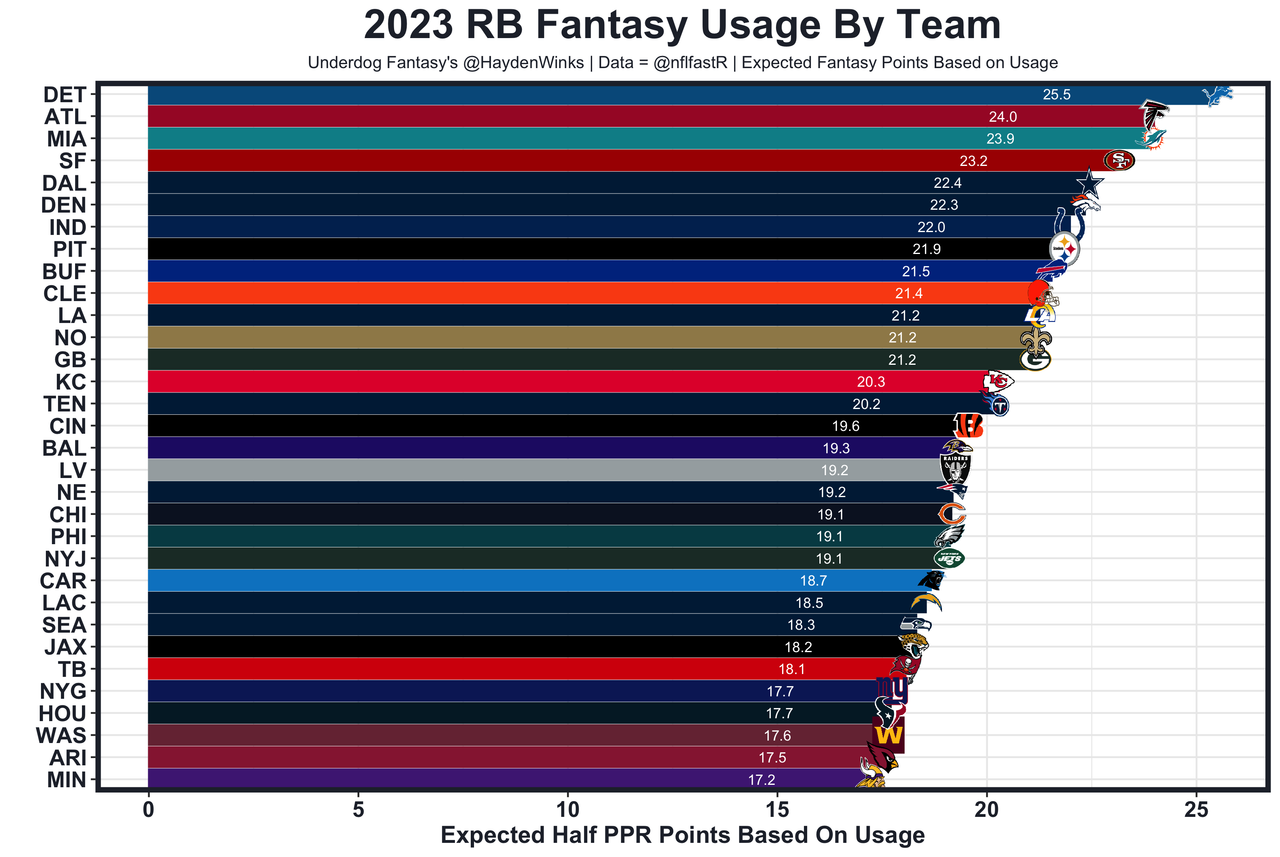
James Conner: Because he's not fast, Conner catches strays but all he does is fill up the box score... on nice efficiency, too. He's been above-average in fantasy points over expected in 5-of-6 seasons as a full-time player, including +25%, +5%, and +11% points over expected during his time in Arizona. Conner only scored 1.5 more TDs than expected last year, so his strong efficiency largely came between the 20s. He had a career-high 5.0 YPC while finishing as the RB1 in yards after contact per carry and broken tackles per carry. Those are likely to come down in his age-29 season, but there's a lot of room for decline. He was the RB6 on RB12 usage and RB11 efficiency last year.
Austin Ekeler: In 2021, Ekeler scored 23% more fantasy points than his usage would suggest, but that's dropped to 8% and -18% respectively over the last two seasons. Last year was a career low, of course. Ekeler battled a high-ankle sprain from Week 1 on, but he's also a smaller back with a ton of NFL hits under his belt.
Tony Pollard: As a committee member, Pollard finished with +24%, +2%, +13%, and +31% fantasy points over expected. Then he broke his ankle and became the Cowboys' lead back in 2023. He bottomed out with -24% efficiency and 9.1 TDs under expected. Yikes. It's difficult to judge if it was the increased volume, the worse OL, the injury, or a combination of all. Either way, Pollard isn't likely to be the game-breaking player he was years ago behind the Titans' work-in-progress OL. The front office and coaching staff are already saying Tyjae Spears will be a 1a/1b member.
Javonte Williams: His career started off fine. Williams was exactly average in fantasy points over expected in 2021, but a torn ACL has set him back. In 2023, Williams was -22% over expected while scoring 4.0 fewer TDs than expected. The Broncos offense looks a bit worse on paper heading into 2024 and it's unsure if coach Sean Payton views Williams as a locked-in starter.
Nico Collins: He's delivered on his developmental, high-upside prospect profile. Collins was a top-12 real life receiver last year and was a perfect fit with C.J. Stroud's downfield accuracy and timing. Collins was one of the most efficient receivers in the NFL, leading to a wild +46% fantasy points over expected. He primarily did so by winning deep. His +18% completion percentage over expected on his deep targets were 9th best, and those led to multiple long scores. The Texans will have to throw more to justify adding Stefon Diggs this year, but Collins' 2023 tape and 2023 metrics looked much better than Diggs'. Collins profiles as a model dunker moving forward. He just may not be quite as good as he was in 2023. Collins was the per-game WR7 last year and is drafted as the WR15 this time around. I'll buy that, especially in best ball.
Brandon Aiyuk: He's a certified model breaker with Kyle Shanahan. Aiyuk has finished with +13%, +22%, +26%, and +47% fantasy points over expected to start his career after getting some tough coaching love early one. Last year's efficiency is bound to regress some after finishing 6th-best in completion percentage over expected on his deep targets (+19%) and 8th-best in receiving TDs over expected (+3.1). Where Aiyuk could make up the difference in lost efficiency is with more volume. He was only the WR36 in per-game usage, and there's a chance Deebo Samuel is traded later this summer for cap reasons. Samuel and George Kittle have a lengthy injury history, so a little target competition luck could turn Aiyuk into one of fantasy's top options. The problem is everyone knows this. He was the WR14 last year and is drafted as the WR11 on Underdog Fantasy right now.
Mike Evans: He still had it last year. Evans has finished with +30%, +15%, +27%, +34%, +11%, and +31% fantasy points over expected despite playing in new offenses with new quarterbacks. The constant is Evans' downfield and red zone dominance. Last year's +31% fantasy points over expected were catalyzed by scoring 6.2 more TDs than his usage would indicate. That was the largest difference among WRs. He's not going to reproduce that again in 2024, especially after losing OC Dave Canales. But the 31-year-old also doesn't have to, compared to his WR18 Underdog Fantasy ADP. Evans was the per-game WR9 on WR14 usage last year and was the WR7 in weekly best ball points because when he scores points, he really scores points.
Davante Adams: 2023 was Adams' first season since 2016 with below-average fantasy points over expected (-8%). In fact, he was above 11% in the previous 7 seasons. Iffy QB play and play-calling were the primary culprits, though neither look promising in 2024 either. Adams had a brutal -9% completion percentage over expected on his deep targets and scored 1.8 fewer TDs than his usage would suggest. Gardner Minshew is only marginally better than what the Raiders' trotted out last year and now Brock Bowers is around for some manufactured touches. Adams is in a tough spot heading into his age-32 season, even if he still looks like a top-12 NFL receiver on tape. He was the WR16 on WR5 usage last year. Sad!
D.J. Moore: After tilting seasons with the Panthers, Moore made the most out of a new situation last year. He was +36% over expected (WR10), leading to a WR13 finish on WR26 usage. He did so by dominating on downfield targets. His +14% completion percentage over expected on targets of 15+ air yards were the 15th best in the NFL, and they helped him score 2.3 more TDs than expected (18th best). Doing so with Justin Fields at QB was extra impressive, but the improved QB situation is at least partially offset by significantly better target competition (Keenan Allen and Rome Odunze). There should be little confidence in how targets and efficiency will play out in this Bears' receiver room, especially with a new playcaller in town, too. He's the WR17 on Underdog Fantasy right now, essentially splitting his production and usage from 2023. That's too rich for me -- regression and target competition are a tough tandem to overcome -- but Moore unquestionably has game-breaking weekly upside.
DeVonta Smith: He's gone from +6% to +25% all the way to +37% fantasy points over expected in his first three years as a pro. Smith was the 14th-best downfield player last year per completion percentage over expected (+15%), leading to 3.2 more TDs than expected. That was 7th best at the position. Those are very difficult to reproduce, though he's a proven model breaker in this Eagles offense. Smith is more valuable in best ball because of his weekly volatility. He had 8 games below 6.5 expected half PPR points (that's really low), yet still had 7 games above 14.0 half PPR points.
A.J. Brown: In comparison to DeVonta Smith, Brown was unlucky last year. 88% of Smith's downfield targets were graded as "catchable" per Sports Info Solutions (WR5). That was just 54% for AJB (64th out of 81 qualifiers). That's the difference between Browns' +33% fantasy points over expected in 2022 versus his +20% finish last year. Both are good. One was elite.
Cooper Kupp: 2023 was the first time Kupp has finished with below-average fantasy points over expected (-6%). He was dealing with a lingering hamstring injury and then suffered a November ankle sprain last year, but this will also be his age-31 season when those injuries seem to bite more often. In the two years prior with Matthew Stafford, however, Kupp was at +40% and 33% fantasy points over expected. An optimistic and arguably reasonable projection would be splitting the difference between 2023 and the two years prior. If so, Kupp is a nice 4th-round selection. He was the per-game WR22 on WR9 usage last season, partially because he scored 1.6 fewer TDs than expected. He's the WR24 on Underdog Fantasy right now.
Marquise Brown: Let's try to put numbers to how different the 2024 Chiefs and 2023 Cardinals are. Brown had a career-low 15% fantasy points over expected last year while trying to catch downfield passes from Josh Dobbs and the boys. He only caught 8-of-31 deep targets for a -17% completion percentage over expected. That was 83rd out of 88 qualifiers. Yikes. Drops were a clear issue, but some of that was due to inaccuracies, a problem thwarted by playing with Patrick Mahomes. Since 2020, Mahomes is at +4% on his downfield throws. A normalization in his long completions will also lead to more TD opportunities during his age-27 contract year.
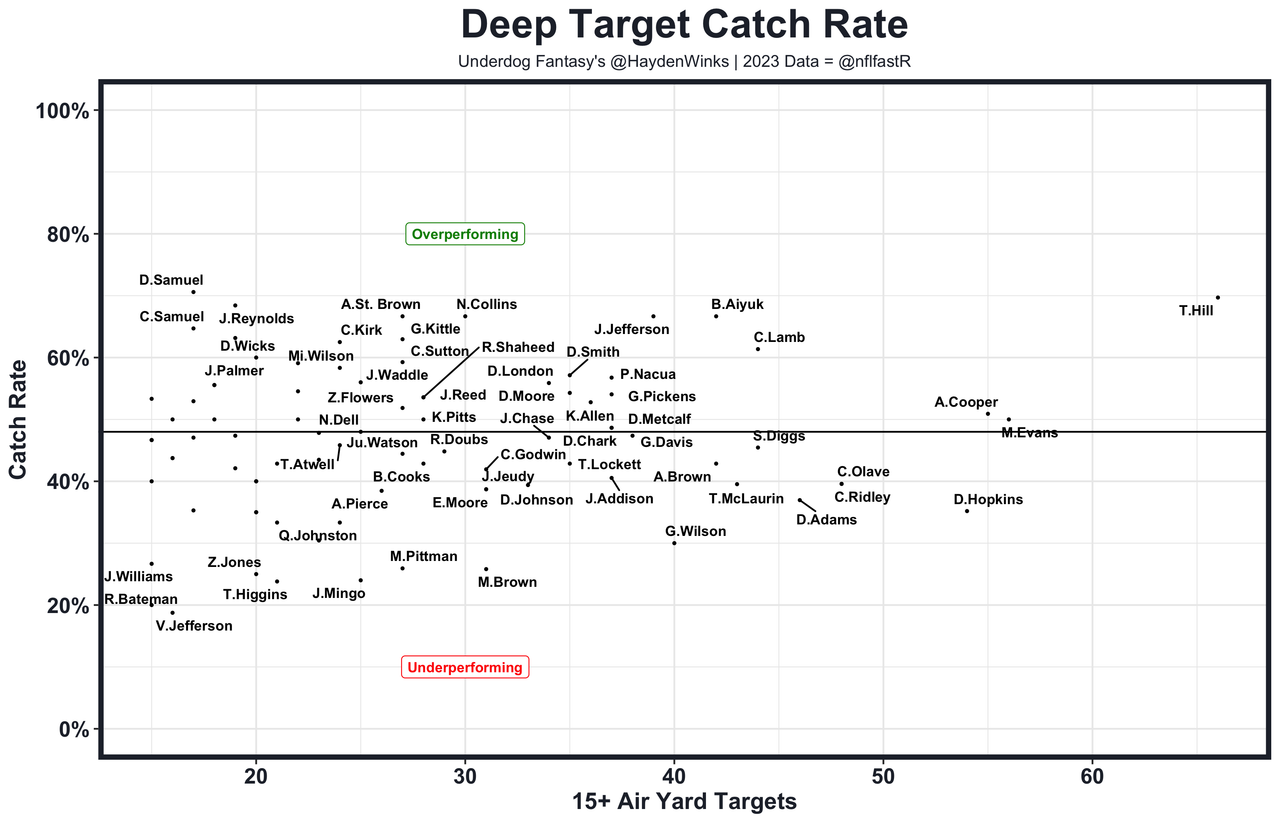
Jayden Reed: There are two forms of regression to watch out for with Reed: target competition and big-play efficiency. Christian Watson missed half of last year. Without him, Reed averaged 10.8 expected half PPR points. That dropped to 6.4 with him healthy, including 4.7 and 4.6 expected half PPR outings in the two playoff games on 50% and 72% route participation. More Watson playing time would be bad news for Reed. Additionally, Reed had a bonkers +30% fantasy points over expected finish. He did so by ranking 16th in completion percentage over expected (+13%) on his deep targets and 15th in receiving TDs over expected (+2.4 scores). Reed also scored 2 times as a rusher. He's a very good player capable of breaking models and handling manufactured touches, but repeating last year's heat will be difficult. He was the per-game WR33 last year and is drafted as the WR32 right now.
Jordan Addison: The Vikings found a legit No. 2 receiver in Addison, but year two expectations need to be realistic after what happened as a rookie. Addison only averaged 6.9 expected half PPR points per game in his 7 contests with Justin Jefferson healthy, versus 10.3 without his super-start teammate. Jefferson is very unlikely to miss as much time in 2024, and Addison's 1st, 3rd, and 4th best fantasy games of the year were without Jefferson and with Kirk Cousins. On top of that, Addison scored 4.2 more TDs than his usage would indicate, which is the 3rd-highest mark of the position. Even if he's a mini model breaker based on his route running ability, Addison has a lot to overcome at a 71st overall ADP on Underdog Fantasy.
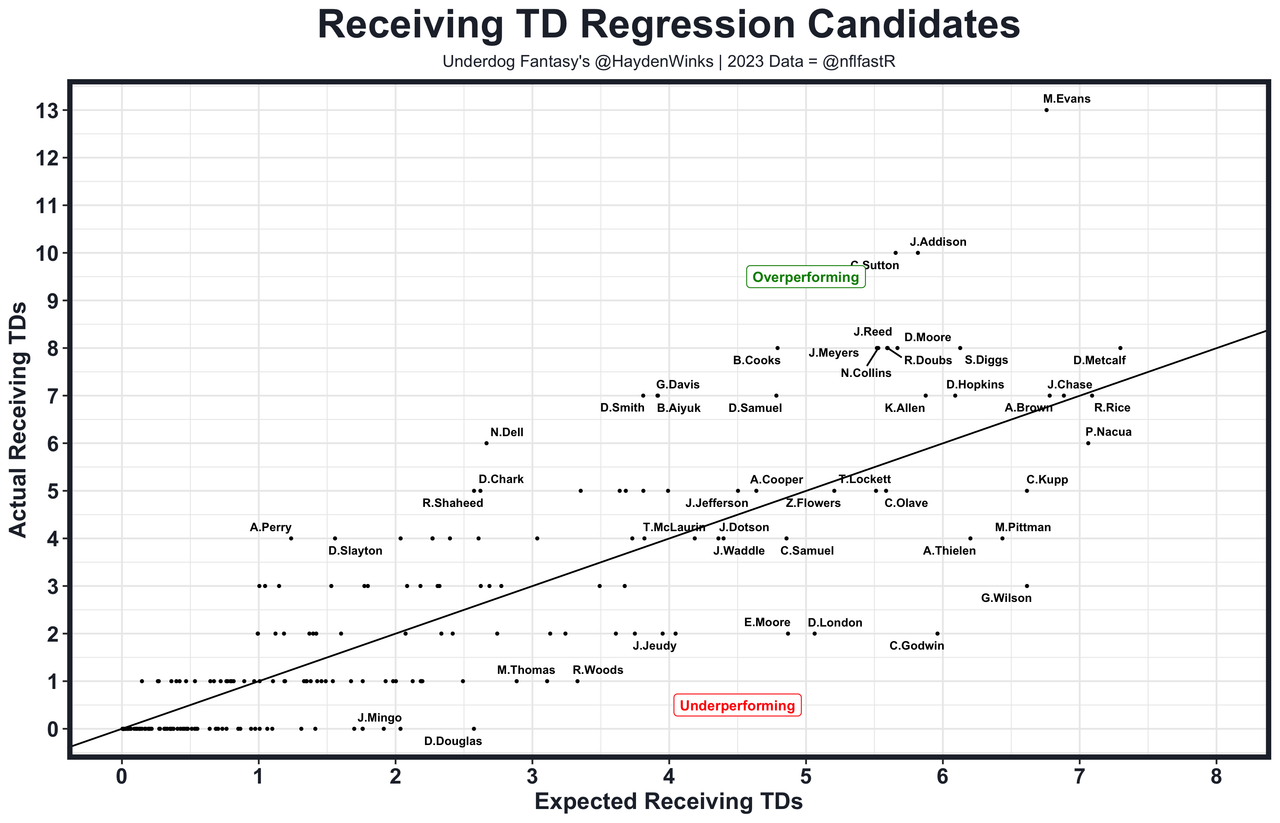
Calvin Ridley: It's been a rollercoaster career. His fantasy points over expected were at +46% with Kyle Shanahan, then +31% and +11% with the Shanny-less Falcons before the foot injury and suspension, and finally -6% in his return with the Jaguars. It's unrealistic to think he bounces back in his age-30 season, especially going from Trevor Lawrence to Will Levis.
DeAndre Hopkins: He hasn't been his peak-self in a couple of seasons. Hopkins buoyed between +9% and +28% fantasy points over expected during his prime but has fell to +6% and +2% over his last two seasons. The Titans added Calvin Ridley and a pass-first coach this offseason, so his usage is hard to project. His efficiency is in a clear downfall heading into his age-32 season, and Will Levis' inaccuracies are likely to work against that turning back. He was the WR31 on WR20 usage in 2023, so his discounted WR46 price tag on Underdog Fantasy seems appropriate.
Chris Godwin: In his three season before his multi-ligament knee tear, Godwin was at +42%, +31%, and +14% fantasy points over expected. Since then, he's been at -1% and 0% while also seeing fewer expected points per game. Baker Mayfield found great rapport with Mike Evans last year, but the new coaching staff wants to prioritize more slot snaps for Godwin this year after struggling more outside. It's a smart move for the Bucs. Godwin just can't be expected to bounce back to his pre-injury and peak-Brady seasons. That said, Godwin was dead last in TDs over expected (-3.9) among 217 qualifiers in 2023. This is his age-28 season and a contract year. If it doesn't happen now, it's Joever. He was the WR40 on WR26 usage last year. He's the WR42 in drafts right now. That's reasonable.
Courtland Sutton: He had one of the most underrated seasons. Sutton finished with +38% fantasy points over expected in a sub-par Broncos offense. He dominated on his deep targets (7th in completion percentage over expected), paving the way to 4.3 TDs over expected. That only trailed Mike Evans. Sutton isn't going to be as good in either of those metrics, but the offense could be a little more consistent with Bo Nix's distributor play-style, especially without Jerry Jeudy, compared to the boom-bust nature of Russell Wilson. He was the WR21 on WR43 usage last year despite being the WR48 in shallow targets per game (below 8 air yards). His upcoming age-29 season is a contract year.
Darius Slayton: Quickly, Slayton was a low-key contributor for the Little Giants last year. His +37% fantasy points over expected caught me off-guard but are enough to suggest that he will likely have a starting role behind Malik Nabers in 2024. Slayton can play X receiver, something Jalin Hyatt and Wan'Dale Robinson can't do, so it wouldn't be a surprise if Slayton finishes ahead of them in routes. The 27-year-old has an $8.1M cap hit. Slayton is a last-round target in best ball.
Sam LaPorta: It's rare for a rookie to finish as the TE3 overall on TE3 overall usage, but LaPorta is a rare tight end capable of winning in all phases. Where LaPorta may struggle to reproduce is in the touchdown department, as he led the position with +4.0 TDs over expected. He can afford to lose 1-4 TDs off his rookie-year total, however, especially if his finish to the season continues. From Week 12 on, LaPorta averaged 11.2 expected half PPR points per game. He was at 8.8 per game before that stretch. He's rightfully being drafted as the TE1 on Underdog Fantasy. The real argument is in the 31st overall ADP. LaPorta was 49th overall in best ball points as a rookie.
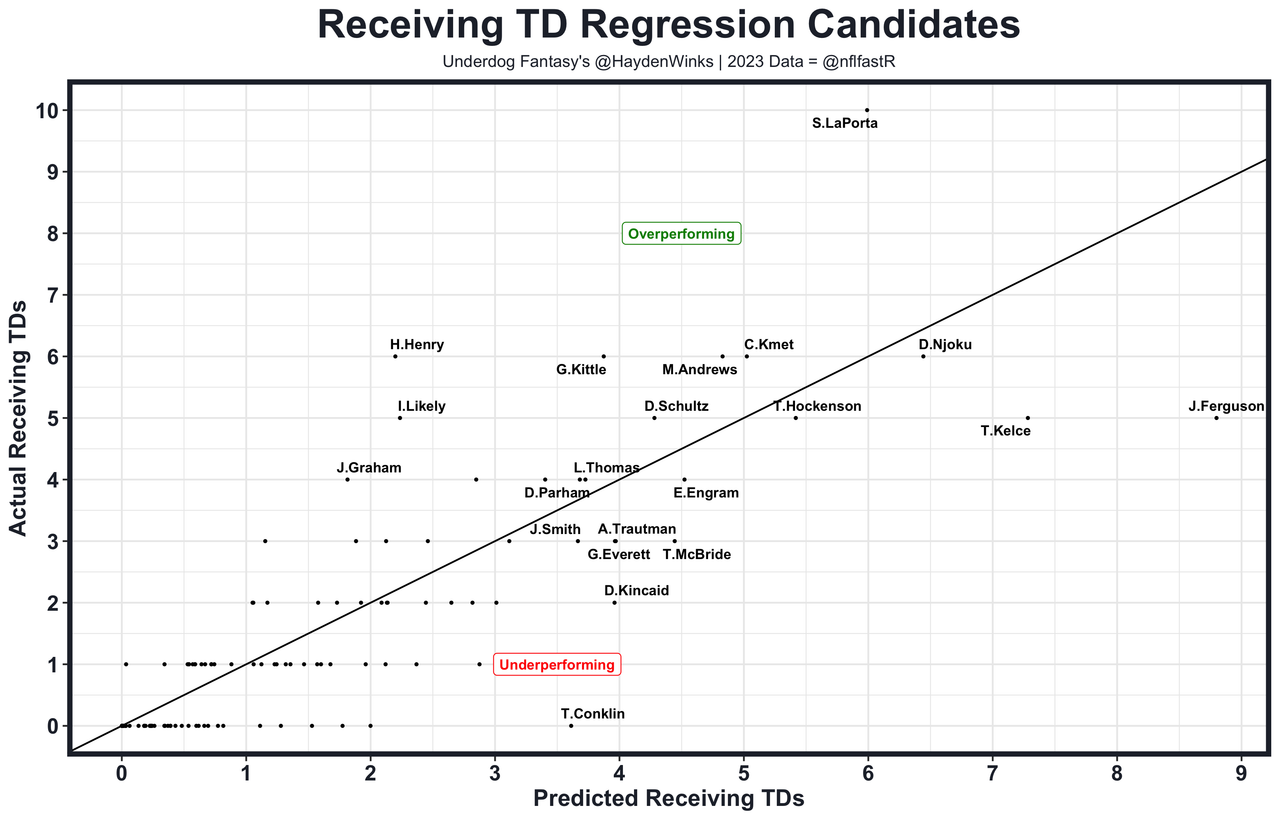
Travis Kelce: Arguably bored of the regular season, Kelce still has glimpses of being the top-20 overall fantasy asset at times, but the overall output has fallen off heading into his age-35 season. He scored +29%, +28%, and +17% fantasy points over expected before that dropped to +6% in the 2023 regular season. His usage also was at a 7-year low. Kelce has his work cut out to be an "elite fantasy TE" with two primary additions to the receiver group, though the market isn't pricing him nearly as high on Underdog Fantasy (38th overall) as he was in the year's previous. Kelce was 56th overall in best ball points last year.
George Kittle: This Hall of Fame run is another reminder that each player has their own efficiency baseline. Kittle has been at +32%, +29%, +48%, and +36% fantasy points over expected over the last four seasons. Insanity! He's capable of breaking the slate despite being a 32-year-old tight end. While his efficiency remains world class, his total usage has regressed with the emergence of Brandon Aiyuk and the addition of Christian McCaffrey. Kittle was at a 6-year-low in expected half PPR points per game (7.2) last season, a trend unlikely to reverse. He averaged 6.8 expected points with Aiyuk and Deebo both in the lineup. That didn't stop him from a TE7 per-game finish last year. He just has to remain that good to be worthy of a 68th overall ADP.
Jake Ferguson: Few had it worst in the red zone than Ferg Daddy. He scored 3.8 fewer TDs than his usage would suggest, while catching just 4-of-12 targets inside the 10-yard line. The Cowboys didn't add anyone to the target tree, and Ferguson was the TE6 in expected half PPR points in 2023. As long as the Cowboys are among the leaders in neutral pass rate and pace, Ferguson is in a great spot for fantasy points.
